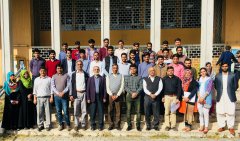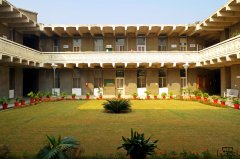Homepage Slideshow
Department of Electronics
M.sc. Scheme of Studies
Courses of M.Sc. (Electronics)
All courses are of 3 credits each
FIRST SEMESTER
El-301 Applied Mathemathcs-1
Computer language: FORTRAN/BASIC language, statement, programming
Complex variables: Functions of complex variables, complex integration, complex series, integration by residues
Matrix theory: Elementary properties of matrices, system of linear equations, functions of operators.
Recommended Books:
1. E. Kreyszig, Advanced Engineering Mathematics, 7th edition (John-Wiley 1994).
2. Arfken, Mathematical Methods for Physics, 2nd edition (Academic Press 1970).
3. S. Lipsehutz and A. Poe, Programming with FORTRAN, Shaum’s Outline Series (McGraw-Hill 1982).
EL-302 Network Analysis
Circuit analysis: Linear circuit element models, independent and dependent sources, time domain response of first and second order circuits,transient and steady state behaviour, time invariant circuits and systems, convolution sinusoidal response. Frequency and time domain analysis: Fourier series and transforms, time domain analysis with Laplace transforms, analysis of filters.
Network theory: Network theorems, two-port networks, network transformations.
Digital systems: Sampling theorem, digital signals and systems, Z-transforms.
Recommended Books:
1. M. E. Van Walkenburg, Network Analysis (Prentice-Hall 1974).
2. A. Desoer and E. S. Kuh, Basic Circuit Theory (McGraw-Hill 1969).
3. A. V. Oppenheim, A. S. Wilsky, and I. T. Young, Signals and systems (Prentice-Hall 1983).
EL-303 Digital Logic Design
Boolean Algebra and Logic gates: Number systems, Boolean algebra, De Morgan’s theorem, karnaugh map,Quine-McCluskey minimization, logic gates
Combination logic circuits: Adders, subtractors decoders, multiplexers, read only memories (ROM), programmable logic arrays.
Sequential logic: Flip-flops, counters, registers, memory devise, codes, error checking, logic families.
Recommended Books:
1. R. J. Tocci, Digital systems…Priciples and Applications (Prentice-Hal 1995).
2. A. P. Malvino and J. A. Brown, Digital Computer Electronics, 3 edition (MacMillan/ McGraw-Hill 1993).
3. T. L. Floyd, Digital Fundamentals, 4th edition (MacMillan Publishers 1990).
EL-304 Quantum and Physical Electronics
Quantum mechanics: Wave-particle duality, uncertainty principle, Schrödinger equation, potential harrier, square well potential,harmonic oscillator, hydrogen atom.
Quantum theory of solids: Free-electron model of metals, origin of band gap, Bloch theorem, kronig-Penny model.
Physics of IC’s: Nature of electrons and atoms, quantum statistics of metals and semiconductors, intrinsic and extrinsic semiconductors, majority and minority carriers, semiconductors devices.
Recommended Books:
1. R. L. Liboff, Introductory Quantum mechanics (Addison Wesley 1980).
2. C. Cohen-Tannoudji, B. Div, and F. Laloe, Quantum Mechanics, Vols, I andII (John-Wiley 1977).
3. S. M. Z. Sze, Semiconductor Device Physics and Technology (John-Wiley 1985).
EL-305 Laboratory – 1
- Introduction to DOS windows (Programming in BASIC/FORTRAN)
- Introduction to instruments; DC circuits
- Waveforms and their parameter Measurements
- AC circuits; natural response
- AC circuits; Forced response
- Ac circuits; complete response
- Ac circuits; steady state response
- Impedance transformations
- Transmission lines Digital laboratory
SECOND SEMESTER
EL-306 Applied Mathematics – II
Elements of probability: Axioms of probability, random variables, distribution and density functions, functions of random variable
Differential equations: Series solutions of differential equations, special functions, Sturm-Liouville problem
Partial differential equations: Laplace, Poisson, heat and wave equations
Numerical methods: Error analysis, numerical solution of equations, interpolation, numerical integration and differentiation,
numerical solution of differential equation, numerical methods in linear algebra
Recommended Books:
1. E. Kreyszig, Advanced Engineering Mathematics, 7th edition (John-Wiley 1994).
2. C. F Geral, Applied Numerical Analysis, 2nd edition (Addison-Wesley 1978).
3. G. Arfken, Mathematical Methods for Physics, 2nd edition (Academic Press 1990).
EL-307 Electronics – 1
Two-terminal devices: PN junction diode characteristics, special purpose diodes, diode circuit models, diode applications
Bipolar transistor: Basic transistor amplifying mechanism, current-voltage characteristics, operating regions, small signal analysis of transistor amplifiers
Field effect transistors: Current-voltage characteristics, amplification, small signal analysis, applications, other field effect devices
Digital electronics: Design of logic gate with discrete element
Recommended Books:
1. R. Boylestad and L. Nashelsky, Electronic Devices and Circuit Theory, 5th edition (Prentice-Hall 1992).
2. J. Mullman and C. C. Halkias, Integrated Electronics: Analog, Digital Circuits and Systems, (McGraw-Hill 1987).
3. R. A. Colclaser, D. A. Neamen, and C. F Hawkings, Electronisc Circuit Analysis (John-Wiley 1984).
EL-308 Control Systems
Control elements: Transducers, switches, actuators, valves, motors
Control Fundamentals: Open loop and closed loop systems, transfer function, signal flow graph, gain formula
Modeling: Mathematical modeling of linear electrical and mechanical systems, state variables, state equations and state diagrams
Analysis and design: Stability, controllability and observability of systems, state variables, state trnasition matrix, transient and steady state response, root locus method, Nyquist criterion, PID controllers, lead lag compensators, pole-zero cancellations
Practical systems: Analog and microprocessor based control systems, design examples
Recommended Books:
1. B.C. Kuo, Automatic Control Systems (Prentice-Hall 1987).
2. J. J. D’Azzo and C H. Houpis, Linear Control Systems: Analysis and Design (Prentice-Hall 1985).
3. B. C. Kou, Digital Control Systems (Holt, Rinehart, and Winston 1980).
EL-309 Computer Architecture
Computer organization: Design methodology, processor design, control design, memory and I/O design
Basic CPU organization: Instruction set design, design of ALU and other functional units, pipelining and multiprocessing, multiprogramming
Memory organization: Memory technology, read only and read/write memory, virtual memory, memory performance, high performance memories
Bus interface and input/output: Bus design and control, input-output systems, I/O processors, DMA.
Recommended Books:
1. R. J. Baron, Computer Architecture (Addison-Wesley 1992).
2. P. Hayes, Computer Architecture and Organization, 2nd edition (McGraw-Hill 1988).
3. R Chandra, Modern Computer Architecture (BPB India 1995).
EL-310 Laboratory – II
a) Diodes and Applications
b) Transistor Characteristics and Biasing
c) BJT Amplifiers
d) Logic Gates Using Discrete Components
e) Digital Circuits
f) AM/FM Modulation and Demodulation
THIRD SEMESTER
EL-311 Communication Theory
Analog Communication Systems: Amplification modulation and demodulation, angle modulation and demodulation, frequency division multiplexing
Digital Communication systems: Line coding, pulse shaping, detection error probability, time division multiplexing
Noise: Autocorrelation, Wire-Khinchine theorem, noise in different modulation schemes
Optimum signal detection: Digital carrier systems, signal space, optimum receiver
Information theory: Entropy, channel capacity, Shannon’s theorem
Error correcting codes: Linear and cyclic codes, burst error-correcting codes, convolutional codes
Recommended Books:
1. B. Saklar, Digital Communication (Prentice-Hall 1988).
2. S. Haykin, An Introduction to Analog and Digital Communication (John-Wiley 1989).
3. B. P. Lathi, Modern Digital and Analog Communication Systems (CBS College Publishing 1983).
EL-312 Electronics – II
High frequency analysis: High frequency small signal models of BJT’s and FET’s frequency response of multistage amplifiers
Feedback: Feedback in linear amplifiers, stability, oscillators
Differential and operational amplifiers: DC analysis, small signal analysis, applications
Electronic systems: Power amplifiers, tuned amplifiers, wave generation and shaping, digital to analog and analog to digital conversion
Recommended Books:
1 R. Boylestad and L. Nashelsky, Electronic Devices and Circuit Theory, 5th edition (Prentice-Hall 1992).
2 R. Boylestad and L. Nashelsky, Electronic Devices and Circuit Theory, 5th edition (Prentice-Hall 1992).
3 R. A. Colclaser, D. A. Neamen, and C. F Hawkings, Electronisc Circuit Analysis (John-Wiley 1984).
EL-313 Electromagnetic Theory
Electrostatics: Coulomb’s and Gauss’ laws, electric dipole, boundary value problems, dielectric, electrostatic energy density
Magneto-statics: Ampere’s and Biot-Savart’s laws, magnetic forces or currents, Faradays’s law of induction, magnetic dipoles, magnetic materials
Maxwell’s equations: Plane waves in vacuum and conducting medium, Poynting vector theorem
Radiation and antennas: Radiation by a system of charges, Lienard-Wiechert potential, linear antennas
Transmission lines: Impedance transformation and matching, Smith charts
Waveguides: Eigenvalue problem of waveguide and cavities, cylindrical and rectangular waveguides, dielectric waveguides
Recommended Books:
1. S. Ramo, J. R Whinnery, and T. Van duz3er, Fields and Waves in Communication Electronics, 3rd edition (John-Wiley 1994).
2. J. D. Kraus, Electromagnetics, 2nd edition (McGraw-Hill 1973).
3. Jordan and K. G. Balmain, Electromagnetic Wave and Radiating Systems, 2nd edition (Prentice-Hall 1968).
EL-314 Computer Programming
Introduction to programming: Software and hardware domains, flow charts, high and low level languages
C-Programming language: Data types statements, structured programming, functions, recursion, implementation of arrays, lists, graphs stacks and queue in ‘C’ Algorithms for searching, sorting and merging, memory management in ‘C’
Recommended Books:
1. R. Fairely, Software Engineering Concepts (McGraw-Hill 1985).
2. M.Z. Zelkowitz, A. C. Shaw, and J. D. Gannon, Principles of Software Engineering and Design (Prentice-Hall 1979).
3. L. Sommerville, Software Engineering, 4th edition (Addison-Wesley 1992).
4. L. Robert, TURBO C++ (Waite Group1991).
5. S. P. Harrison and G. Steele Jr., C: A. Reference Manual (Prentice-Hall 1987).
6. S. Prata, C++ Primer Plus (Waite Group 1993).
EL-315 Laboratory – III
a) C-Programming language
b) Op-Amp Applicaitons
c) Filters
d) Oscillators
e) Power amplifiers
f) Data converters (A/D and D/A)
g) Super heterodyne receiver
h) On/off and proportional control, calculation of system response parameters
i) Regulated power supply
j) Phase locked loops, FM detection
FOURTH SEMESTER
EL-317 Communication Systems
Telephony: Switching and multiplexing, queuing theory, line coding
Transmission and propagation: Antenna structures, arrays, propagation of signal over flat and spherical earth
Radar: Basic radar equation, radar signal processing
Recommended Books:
1. R. E. Collin, Antennas and Radio Wave Propagation (McGraw-Hill 1985).
2. A. Skolonik, Introduction to Radar (McGraw-Hill 1978).
EL-318 Laser and Fiber Optics
Laser theory: Concept of laser, lasing condition and gain, rate equation approach, CW and transient laser behaviour, Q switching,
line broadening mechanisms, types of laser
Fiber optics: Theory of dielectric waveguides, single-mode and multimode fibers, dispersion effects in optical fiber, fiber optic communication
Nonlinear optics: Crystal optics, optical activity, electrooptic effect, Faraday’s effect, second harmonic generation
Recommended Books:
1. O. Svelto, Principles of Lasre (Plenum 1982).
2. A. E. Siegman, Laser (University Sciences 1986).
3. A. Nussbaum and R. A. Phillips, Contemporary Optics for Scientists and Engineers (Prentice-Hall 1976).
EL-319 Microprocessor Based Design
Digital system components: MSI, LSI and VLSI circuits and applications
Microprocessors: 8, 16 and 32-bit microprocessor instruction set, interfacing to memory and I/O devices, timing diagrams, programmable logic devices, digital signal processors and microcontrollers
Recommended Books:
1. J. Fluchen, An Introduction to Micro-computer Systems…Architecture and Interacting (Addison-Wesley 1990).
2. A. Mitchel, 32-bitMicroprocessors (McGrraw-Hill 1989).
3. I. A. Singh, 16-bit and 32-bit Micro-processor Architecture, Software, and interface Techniques (Prentice-Hall 1991).
EL-320 Electronics – III
Power switching devices: Power diodes, transistors, MOSFETs, thyristors, JGBts., transformers
Communication techniques: Natural, self impulse, resonant pulse external pulse
Pulse width modulation techniques: Single, multiple, sinusoidal and phse displacement control
Power electronics circuits: Control rectifiers, DC choppers, switched mode power supplied, inverter, power conditioners and uninterruptible power supplies
Recommended Books:
1. M. H. Rashid, Power Electronics: Circuits, Devices and Applications, 2nd edition (Prentice-Hall 1993).
2. D. A. Bradley, Power Electronics, 2nd edition (Chapman and Hall 1995).
3. N. Mohan, T. M. Undeland and W. P. Robbins, Power Electronics: Converters, Applications and Design (John-Wiley 1989).
EL-321 Software Engineering
Introduction: Computing systems, hardware dependent and independent kernels, software management
Software development: Modeling, algorithms, programming methodology, testing, maintenance, enhancement
Data structures: Arrays, lists, graphs, trees, file structures, database management systems Object-Oriented Programming: C++, Visual C
Recommended Books:
1. R. Farely, Software Engineering Concepts (McGraw-Hill 1985).
2. M. S. Zelkowitz, A. C. Shaw, and J. D. Gannon, Principles of Software Engineering and Design (Prentice-Hall 1979).
3. I. Sommerville, Software Engineering, 4th edition (Addison-Wesley 1992).
EL-322 Signal Processing
Filters: Analog filters, digital filters (Fir and IIR)
Transforms: Fast Fourier transforms, number transforms
Applications: Frequency detection, PCM time-division multiplexing, frequency-division multiplexing echo cancellation, linear predication
Recommended Books:
1. Michael A. Nielson, Issac Chuang, Quantum Computation and Quantum Information, (Cambridge 2000).
2. Dirk Bouwmeester, A. Ekert, A. Zeilinger, The Physics of Quantum Information: Quantum Cryptography, Quantum Teleportation, (Springer Verlag 2000).
3. Hoi-Kwong Lo, Sandu Popescu, Tim Spiller, Introduction to Quantum Computation and Information (World Scientific 2001).
EL-324 Digital Design Using Verilog-HDL
Introduction to Electronics Design Automation (EDA, Hardware Modeling with the Verilog HDL, Event-driven Simulation and Test Branches, Logic system, Data Types and Operators for Modeling in Verilog HDL, User Define Permitives, Verilog Models of Propagation Delays, Behavioural Description in Verilog HDL, Synthesis of Combinational Logic, Synthesis of Sequential Logic, Synthesis of Language Construct, Switch-Level Models in Verilog, UART Design Exercise, BIT-Slice AMD2901 Microcontroller Design Exercise, Rapid Prototyping with Xilinx FPGA
Recommended Books:
1. M. D. Ciletti, Modeling, Synthesis and Rapid Prototyping with the Verilog HDL, (Prentice-Hall 1999).
2. Samir Palnitkar, Verilog HDL, Aguide to Digital Design and synthesis (Sun Microsystems 2003).
EL-325 Project
A final semester project will be offered to students in order to develop better understanding of the subject as well as to furnish their abilities to work independently. The project will help to prepare students for modern technological challenges. Project will be an optional course for student. Following are the rules for opting and evaluation procedure of the project.
1. Project in final semester is option.
2. Project will be of 3 credits.
3. Teacher willing to offer a project will announce it before the start of the semester.
4. A supervisor can supervise maximum of 5 projects in a semester.
5. The work done by supervisor will not be credited into teacher’s weekly work load.
6. Project will be offered to students individually.
7. After successfully clearing 15 courses a student can register for a project Evaluation of the project will be done by supervisor and a committee. The supervisor will submit his evaluation of the project along with thesis/project report submission to the chairman. Supervisor will evaluate the project by awarding marks out of a maximum of fifty marks. A committee will evaluate the project by awarding the rest of the 100 marks. These 100 marks are divided equally between student’s presentation/demonstration and the report submitted by him.
EL-326 Image Understanding
Introduction, nature of light and neurophysiology, digitized image formation and basics, content of images, color and texture analysis, Mathematical Morphology, segmentation, object recognition and meanings of image understanding, features and applications, Content-Based Image Retrieval (CBIR), image classification and evaluation, remote sensing and interpretation of satellite imagery, medical image understanding technology.
Recommended Books:
1. M. Sonka, V. Hlavac and R. Boyle, Image Processing, Analysis and Machine Vision, 2nd Ed., PWS Publishing, 1998.
2. P. Soille, Morphological Image Analysis, 2nd Ed.,Springer, 2003.
3. Larry S. Davis, Foundations of Image Understanding, Kluwer International Series in Engineering and Computer Science: vol. 628. August, 2001. ISBN: 0-7923-7457-6.
4. S. Ullman and W. Richards (eds). Image Understanding 1989. New Jersey: Ablex Publishing Co., 1990.
EL-330 Wireless Communication
Cellular Wireless Networks and System Principles, Path loss and Shadowing. Frequency Hopping Time Hopping Modeling of Multipath Wireless channels. Capacity of Wireless channels. Routing in Wireless Networks. Opportunistic Communication. Data vs voice systems. Signal Encoding and Modulation techniques, Performance of Digital Modulation over Wireless Channels. Diversity. Antennas and Radio Propagation, Multiple Antennas and Space-Time Communication. Equalization. Multi-carrier Modulation. Spread Spectrum, UTRA Spreading and Modulation, Coding and Error Control, Multiple access techniques, Generations of wireless systems, UMTS network and radio access technology, CDMA, Soft handoff and power control, Wireless LANs, Personal communications services (PCS) Wireless LANs. Mobile ad hoc Networks. Wireless sensor Networks. IEEE 802.1x
Recommended Books:
1.Wireless Communications: Principles & Practice by T.S. Rappaport, Second Edition, Prentice Hall, 2002.
2.Modern Wireless Communications by Simon Haykin & Michael Moher, Prentice Hall, 2004
3.Wireless Communication by Andrea Goldsmith, Cambridge University Press, 2005.
4.Fundamentals of Wireless Communication by D. Tse and P. Viswanath, Cambridge University Press, 2005.
Students highlight
User Login
Connect with us
Postal Address
Department of Electronics
Quaid-i-Azam University Islamabad, 45320, Pakistan.
Tel: +9251-9064-3161
Chairman
Tel: +9251-9064-3500
Department Office
Tel: +9251-9064-3161
Email: chairele@qau.edu.pk









